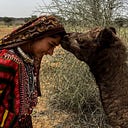How Mapping Indigenous Knowledge is Helping Nomadic Communities to Fight Climate Change — and Extinction
Source: Wired, UK
When Hindou Oumarou Ibrahim was growing up in the 1980s, along the shores of Lake Chad, she was dazzled by her elder’s knowledge of the land. “Reading the clouds, listening to the wind, they could tell you that in several hours it’s going to rain,” Ibrahim recalls.
Ibrahim is Mbororo, part of a nomadic pastoralist people who have grazed the land around Lake Chad for millennia. “We live in harmony with nature because we depend on it for food, fresh water, materials,” Ibrahim says. An award-winning climate change and indigenous rights advocate, and environmental activist, Ibrahim has spent her career advancing the rights of indigenous communities, particularly those around Lake Chad.
As with indigenous groups in the Arctic and the South Pacific, the pastoral Mbororo communities around Lake Chad have found themselves on the front lines of climate change. “In Chad, right now, the climate is already changing. I was home in the community during the first days of April, where we faced a heatwave of 130°F (54.4°C),” Ibrahim says. “In the Sahel, the average temperature has increased by more than 1.5°C over the last century, meaning we have already missed the Paris Agreement target. Extreme weather events, with drought, floods, and desertification, are becoming the new reality.”
The shifting climate — drier, hotter, and more extreme — has devastated the livelihoods of the nomadic pastoral communities, and particularly the cattle herds that are the foundation of their existence. “For example, 20 years ago, we used to milk our cattle twice a day, even during the dry season. Today, because of climate change and the lack of water, we can milk them only once every two days. That means that milk production, which is our main economic activity, has been divided by four within a couple of generations,” Ibrahim says.
As the local climate has changed and resources come under strain, the situation has put pressure on local communities — particularly between pastoralists, farmers, and fishermen. In some cases, the pressure has forced people to migrate to urban areas, where they end up living in informal settlements. “That’s why I have decided to fight. Because if we don’t take action against climate change, my people simply face extinction.”
Ibrahim was determined to help. In 2005, Ibrahim founded the Association Des Femmes Peules & Peuples Autochtones du Tchad (The Association for Indigenous Women and Peoples of Chad, or AFPAT), which works with indigenous communities to help advance women’s rights, and the rights of indigenous people. In her activism work with local women, she saw resources dwindling and was reminded of her elders and their knowledge of the land. “In Chad, official meteorological forecasts don’t always reach rural areas. So who do the farmers consult about when to plant their crops?
“Who provides the forecast of whether or not it’s going to rain tomorrow? An indigenous grandmother,” she says. “In my community, a grandmother is far more useful than a smartphone.”
Inspired by this, AFPAT has pioneered the use of what Ibrahim calls “participatory mapping.” “We develop maps with satellite images of an area, informed by indigenous traditional knowledge from our elders. This includes identifying where there is clean water, trees for food, and wood — even the land is considered sacred, and holds spiritual meaning,” Ibrahim says. “It helps us to share the resources, to define rules to sustainably manage our environment, to prevent and solve conflict.”
Ibrahim first developed the idea in Baïbokoum, in southwest Chad, assembling 500 indigenous leaders to help to map the natural resources in the area. In each case, AFPAT works with groups of local people — farmers, pastoralists, fishermen, and villagers — to begin a conversation about local resources, from water to forests, to transhumance (or herding) corridors, which are vital for pastoralists and their livestock. “We then put all the elements on a large map, each group adding, completing or correcting what the previous has done,” Ibrahim explains. The mapping is done in the local native language, and all groups of society are encouraged to take part.
“What is amazing is that you see the added value of all groups. Women have unique knowledge that men don’t, for instance on specific crops they use for cooking that are resilient to drought in case of a food crisis, or for traditional medicine. It’s also great to learn and map from the memories of our grandfathers that some fresh water sources still exist, and can provide water even in the middle of the dry season,” Ibrahim says. The maps are then digitized so that they can be shared. The data has been adopted by the local government; in others, the process is prompting local solutions.
Maps, after all, can show the way — to something better. “People still believe that indigenous peoples represent the past,” Ibrahim says. “But let me tell you that we are the future.”
